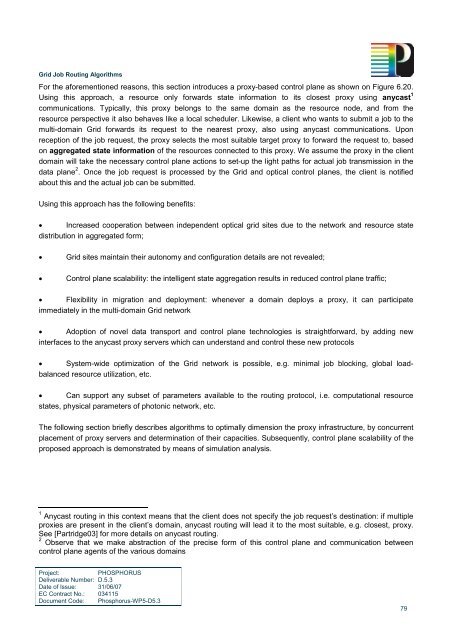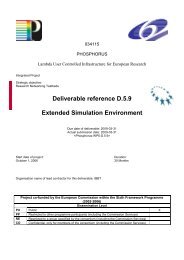Grid Job Routing Algorithms - Phosphorus
Grid Job Routing Algorithms - Phosphorus
Grid Job Routing Algorithms - Phosphorus
Create successful ePaper yourself
Turn your PDF publications into a flip-book with our unique Google optimized e-Paper software.
<strong>Grid</strong> <strong>Job</strong> <strong>Routing</strong> <strong>Algorithms</strong>For the aforementioned reasons, this section introduces a proxy-based control plane as shown on Figure 6.20.Using this approach, a resource only forwards state information to its closest proxy using anycast 1communications. Typically, this proxy belongs to the same domain as the resource node, and from theresource perspective it also behaves like a local scheduler. Likewise, a client who wants to submit a job to themulti-domain <strong>Grid</strong> forwards its request to the nearest proxy, also using anycast communications. Uponreception of the job request, the proxy selects the most suitable target proxy to forward the request to, basedon aggregated state information of the resources connected to this proxy. We assume the proxy in the clientdomain will take the necessary control plane actions to set-up the light paths for actual job transmission in thedata plane 2 . Once the job request is processed by the <strong>Grid</strong> and optical control planes, the client is notifiedabout this and the actual job can be submitted.Using this approach has the following benefits:• Increased cooperation between independent optical grid sites due to the network and resource statedistribution in aggregated form;• <strong>Grid</strong> sites maintain their autonomy and configuration details are not revealed;• Control plane scalability: the intelligent state aggregation results in reduced control plane traffic;• Flexibility in migration and deployment: whenever a domain deploys a proxy, it can participateimmediately in the multi-domain <strong>Grid</strong> network• Adoption of novel data transport and control plane technologies is straightforward, by adding newinterfaces to the anycast proxy servers which can understand and control these new protocols• System-wide optimization of the <strong>Grid</strong> network is possible, e.g. minimal job blocking, global loadbalancedresource utilization, etc.• Can support any subset of parameters available to the routing protocol, i.e. computational resourcestates, physical parameters of photonic network, etc.The following section briefly describes algorithms to optimally dimension the proxy infrastructure, by concurrentplacement of proxy servers and determination of their capacities. Subsequently, control plane scalability of theproposed approach is demonstrated by means of simulation analysis.1 Anycast routing in this context means that the client does not specify the job request’s destination: if multipleproxies are present in the client’s domain, anycast routing will lead it to the most suitable, e.g. closest, proxy.See [Partridge03] for more details on anycast routing.2 Observe that we make abstraction of the precise form of this control plane and communication betweencontrol plane agents of the various domainsProject:PHOSPHORUSDeliverable Number: D.5.3Date of Issue: 31/06/07EC Contract No.: 034115Document Code: <strong>Phosphorus</strong>-WP5-D5.379






